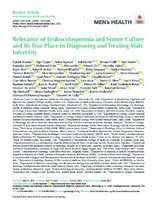| dc.contributor.author | Sharma, Rakesh | |
| dc.contributor.author | Gupta, Sajal | |
| dc.contributor.author | Henkel, Ralf | |
| dc.date.accessioned | 2021-06-21T11:16:06Z | |
| dc.date.available | 2021-06-21T11:16:06Z | |
| dc.date.issued | 2021 | |
| dc.identifier.citation | Sharma, R. et al. (2021). Relevance of leukocytospermia and semen culture and its true place in diagnosing and treating male infertility. The World Journal of Men's Health,39, e32 | en_US |
| dc.identifier.issn | 2287-4690 | |
| dc.identifier.uri | https://doi.org/10.5534/wjmh.210063 | |
| dc.identifier.uri | http://hdl.handle.net/10566/6311 | |
| dc.description.abstract | The current WHO 2010 manual for human semen analysis defines leukocytospermia as the presence of peroxidase-positive
leukocytes at a concentration >1×106
/mL of semen. Granular leukocytes when activated are capable of generating high levels
of reactive oxygen species in semen resulting in oxidative stress. Oxidative stress has been correlated with poor sperm quality, increased level of sperm DNA fragmentation and low fertility potential. The presence of leukocytes and pathogens in the
semen may be a sign of infection and/or localized inflammatory response in the male genital tract and the accessory glands.
Common uro-pathogens including Chlamydia trachomatis, Ureaplasma urealyticum, Neisseria gonorrhoeae, Mycoplasma
hominis, and Escherichia coli can cause epididymitis, epididymo-orchitis, or prostatitis. The relationship between leukocytospermia and infection is unclear. Therefore, we describe the pathogens responsible for male genital tract infections and their
association with leukocytospermia. The review also examines the diagnostic tests available to identify seminal leukocytes.
The role of leukocytospermia in male infertility and its management is also discussed. | en_US |
| dc.language.iso | en | en_US |
| dc.publisher | Korean Society for Sexual Medicine and Andrology | en_US |
| dc.subject | Culture | en_US |
| dc.subject | Endtz | en_US |
| dc.subject | Infections | en_US |
| dc.subject | Inflammation | en_US |
| dc.subject | Leukocytes | en_US |
| dc.subject | Spermatozoa | en_US |
| dc.title | Relevance of leukocytospermia and semen culture and its true place in diagnosing and treating male infertility | en_US |
| dc.type | Article | en_US |

